To write a simple rental agreement, start by clearly identifying both parties, including full legal names. Describe the property details, including address and amenities, and specify the lease term and renewal options. Outline payment terms, including rent amount, due dates, and deposits, as well as each party’s responsibilities for maintenance and conduct rules. Don’t forget to include security deposits and signatures. Continuing will help you guarantee your agreement covers everything for a smooth tenancy.
Key Takeaways
- Clearly identify the landlord and tenant by full legal names and include contact information.
- Describe the rental property, including address, size, amenities, and any shared facilities.
- Specify the lease term, rent amount, payment schedule, and security deposit details.
- Outline property rules, including maintenance responsibilities, conduct restrictions, pet policies, and quiet hours.
- Include signature lines for all parties, ensuring the agreement is signed and dated to be legally binding.
Clarify the Names of Parties Involved
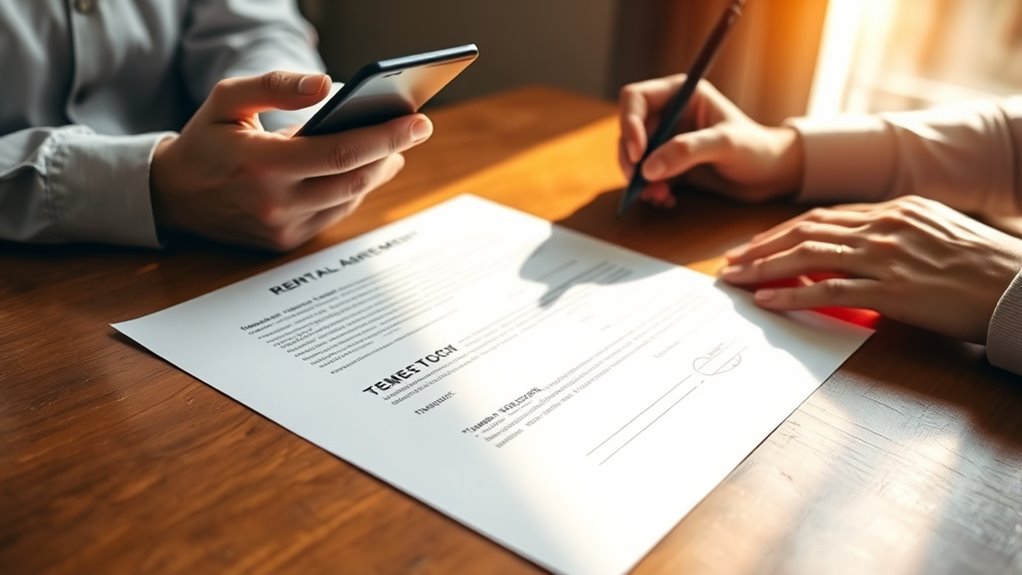
Have you clearly identified who the landlord and tenant are in your agreement? This step is essential to avoid confusion later, especially during tenant screening or lease termination. Clearly state the full legal names of both parties to guarantee everyone understands their roles. Use consistent titles throughout the document, such as “Landlord” and “Tenant,” to prevent ambiguity. Properly identifying parties also helps verify identities during background checks and tenant screening processes. If disputes arise, clear names make it easier to enforce lease terms or handle lease termination. Double-check spellings and details to prevent mistakes. Ultimately, clarity at this stage sets a solid foundation for a smooth landlord-tenant relationship and simplifies any legal procedures down the line. Including the correct identification of parties ensures that the agreement reflects the true contractual relationship.
Describe the Property and Rental Terms
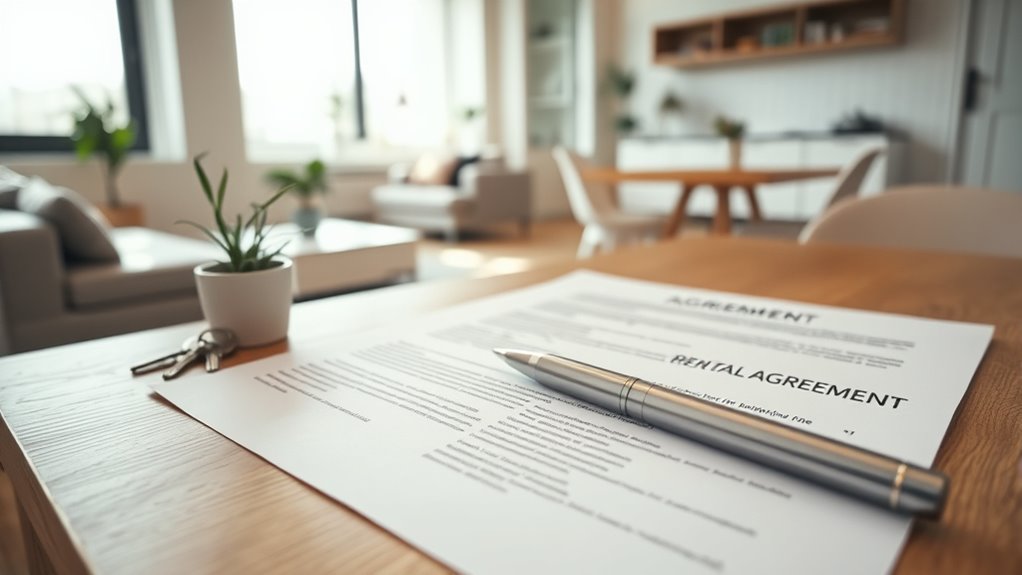
To clearly define the rental property and its terms, specify the exact address, including unit or apartment numbers if applicable. Describe the property’s size, type, and condition to set clear expectations. Include details about utilities management, such as which utilities are included or the tenant’s responsibilities for payment. Clearly state parking arrangements, noting if parking is assigned, shared, or available on a first-come, first-served basis. Mention any shared amenities or building rules related to the property. This section helps avoid misunderstandings by outlining what the tenant can expect and what is expected of them. Keep the description precise and exhaustive to ensure both parties are on the same page regarding the property and rental conditions. Additionally, specifying property features can help clarify what amenities are included and their condition.
Specify the Payment Details and Schedule
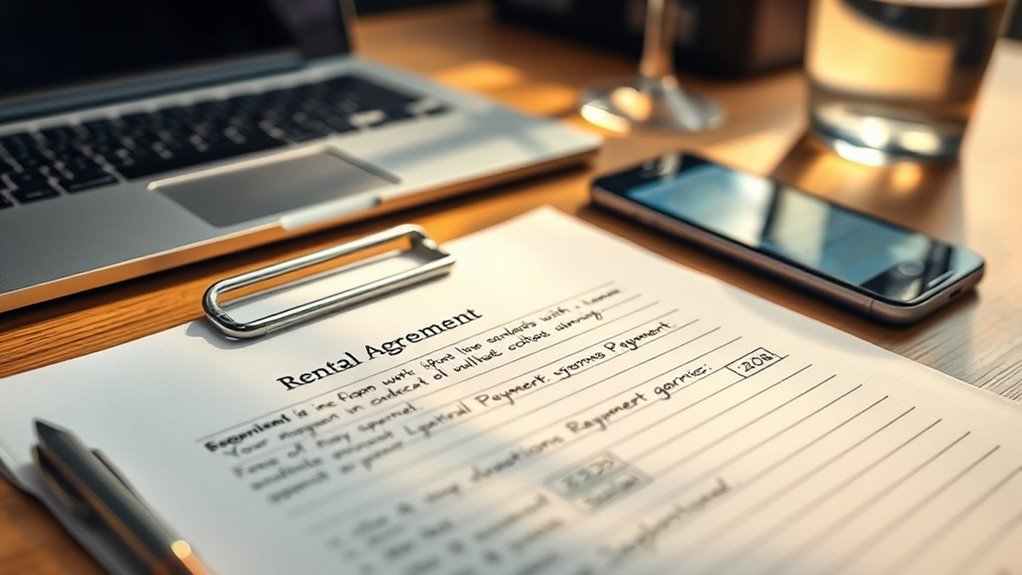
Establishing clear payment details and a schedule helps both you and the landlord stay on the same page about financial obligations. Clearly specify the payment schedule, including due dates and frequency, such as monthly or quarterly. This guarantees there’s no confusion about when payments are expected. Also, outline the payment method you’ll use, whether it’s bank transfer, check, or online payment platform. Being specific about these details prevents misunderstandings and late payments. Make sure both parties agree on the schedule and method before signing the agreement. This clarity helps maintain a smooth landlord-tenant relationship and avoids potential disputes over rent payments. Always document these details in the rental agreement for transparency and accountability. Additionally, understanding the effectiveness of payment methods can help ensure timely and secure transactions.
Outline the Responsibilities of Both Landlord and Tenant

You need to clearly define the tenant’s payment obligations, including rent and other fees. Both you and the tenant should understand your responsibilities for property maintenance and repairs. Additionally, establish rules and restrictions on use to guarantee everyone knows what’s expected. To promote a positive living environment, consider incorporating clear communication strategies and expectations from the outset.
Tenant Payment Obligations
Typically, tenants are responsible for paying rent on time and adhering to the payment schedule outlined in the lease. Meeting payment deadlines helps avoid late fees and keeps your rental in good standing. Your landlord may specify how and when rent should be paid, such as via check, online transfer, or other methods. It’s essential to comprehend your obligations clearly. Be aware of: – Payment deadlines to ensure timely payments – Possible late fees if payments are overdue – How to handle partial payments, if allowed – The importance of keeping records of all payments. Sticking to these responsibilities prevents unnecessary charges and maintains a positive rental relationship. Always review your lease to understand your payment obligations thoroughly. Additionally, understanding the importance of timely payments helps ensure a smooth rental experience.
Property Maintenance Responsibilities
Both landlords and tenants have specific responsibilities when it comes to property maintenance, ensuring the rental stays in good condition throughout the lease term. As a tenant, you’re responsible for daily property upkeep, such as keeping the space clean and reporting any damages promptly. Following the maintenance schedule outlined in your lease helps prevent larger issues. Landlords, on the other hand, should handle repairs related to structural integrity, plumbing, and electrical systems. They’re also responsible for maintaining common areas and ensuring the property complies with safety standards. Clear communication about maintenance needs helps both parties avoid misunderstandings. Utilizing proper cleaning tools, like best vacuums for dust removal in 2024, can assist tenants in maintaining cleanliness and air quality. By understanding and respecting these responsibilities, you help preserve the property’s value and create a positive renting experience.
Rules and Use Restrictions
Establishing clear rules and use restrictions helps guarantee a harmonious rental experience for both parties. You should specify pet restrictions to prevent damage or disturbances, such as limiting the number of pets or prohibiting certain breeds. Noise limitations are also essential to maintain a peaceful environment; set acceptable noise levels and quiet hours. Additionally, outline restrictions on common issues, like:
- No illegal activities on the property
- Proper disposal of trash and waste
- Restrictions on smoking indoors
- Guidelines for parking and shared spaces
- The importance of privacy and cookie management to ensure a secure and comfortable environment for all residents.
Include Rules and Restrictions for the Property
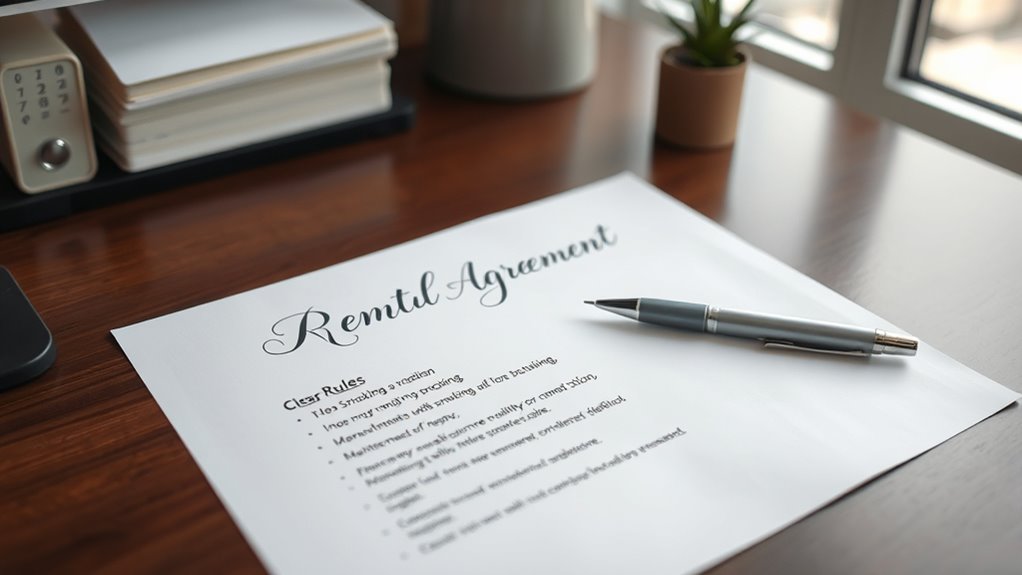
You need to clearly state rules about pets, noise, and conduct to keep the property comfortable for everyone. Setting expectations upfront helps prevent misunderstandings and disputes later on. Make sure your restrictions are specific and easy to understand. Including guidelines about property maintenance can further ensure the space remains in good condition for all tenants.
Pet Policy Restrictions
Are pets allowed on the property? If so, you need clear rules in your rental agreement. First, specify any breed restrictions, as some properties don’t permit aggressive breeds to prevent pet damage. You should also outline weight limits or size restrictions. Additionally, consider including rules like: – Pets must be vaccinated and up-to-date on health checks – Tenants are responsible for cleaning up pet waste – Damage caused by pets, including pet damage, is the tenant’s responsibility – No pets are allowed on furniture or in common areas without permission. Implementing a pet policy helps set clear expectations and reduces potential issues during tenancy. These restrictions protect the property and ensure a smooth landlord-tenant relationship. Clearly stating breed restrictions and pet-related responsibilities helps prevent disputes and maintains the property’s integrity.
Noise and Conduct Rules
To maintain a peaceful living environment, clear noise and conduct rules are essential. You should specify acceptable noise levels and quiet hours to prevent noise disturbances that could disturb neighbors. Make it clear that loud music, shouting, or other disruptive behaviors are not allowed during designated quiet times. Also, outline conduct expectations to minimize conduct violations, such as respecting neighbors’ privacy and avoiding disruptive gatherings. Set consequences for repeated violations, like warnings or eviction procedures. Emphasize that residents are responsible for their guests’ behavior, too. These rules help ensure everyone’s comfort and safety. Additionally, integrating security systems can further deter disruptive behaviors and enhance overall safety. By establishing clear guidelines, you create a respectful community where noise disturbances and conduct violations are minimized, making the property a more pleasant place to live for all tenants.
Detail the Security Deposit and Refund Policy
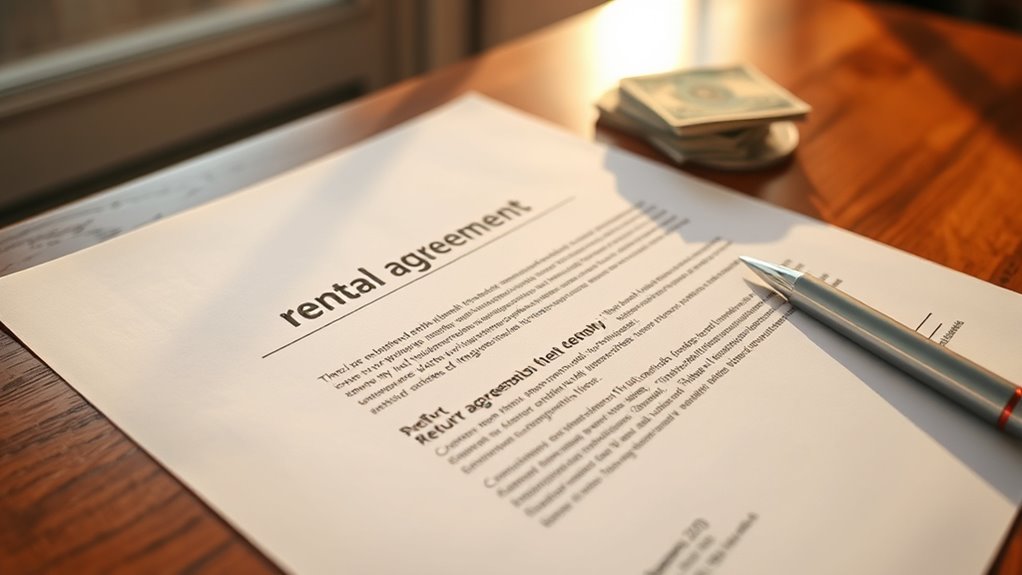
A security deposit is a sum of money paid by the tenant upfront to cover potential damages or unpaid rent, providing protection for the landlord. Clearly outline your security deposit amount and specify your refund policy to avoid confusion. Include details such as:
- Conditions for deducting from the security deposit
- Timeline for refund after lease ends
- Any non-refundable fees or charges
- Circumstances that may delay or reduce the refund
Make sure your refund policy specifies how and when the tenant will receive their deposit back, and under what conditions deductions may apply. Transparency helps prevent disputes and ensures both parties understand their rights regarding the security deposit. Being clear about these details makes your rental agreement straightforward and fair.
Define the Duration of the Lease and Renewal Conditions
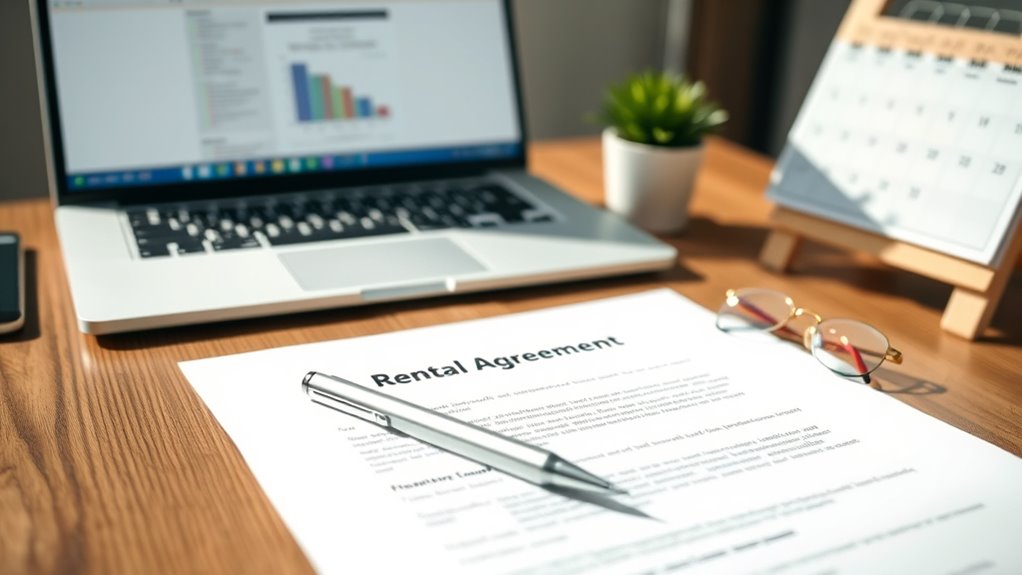
Clearly defining the duration of the lease and the renewal conditions helps set expectations and provides stability for both you and your tenant. Specify the exact length of the lease, such as six months or one year, to avoid confusion. Include clear lease renewal procedures, detailing how and when tenants can request renewal and whether rent increases apply. Outline lease termination conditions, such as notice periods or reasons for early ending, to ensure both parties understand their rights. Clarify if the lease automatically renews or requires a new agreement. This clarity helps prevent disputes and streamlines the process when the lease expires. By setting these terms upfront, you create a transparent, fair arrangement that benefits everyone involved.
Signatures and Agreement Acknowledgment
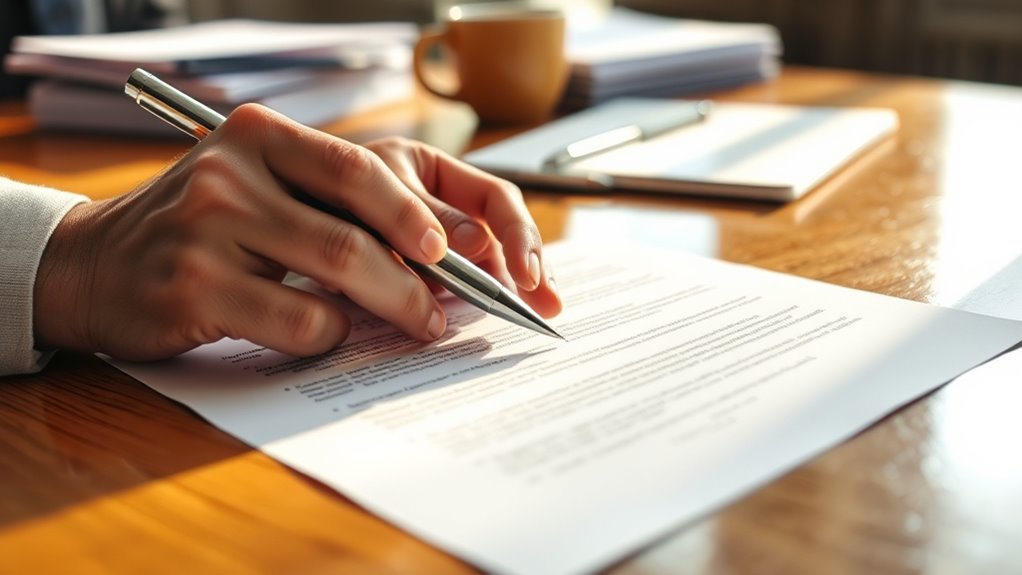
Once all the terms of the rental agreement are finalized, both you and your tenant need to sign the document to make it legally binding. Proper signature authentication guarantees that the agreement is enforceable and recognized legally. To strengthen the legal binding, follow these steps:
- Sign in the presence of a witness or notary if required.
- Use consistent signatures across all pages.
- Ensure all parties sign and date the document.
- Keep copies of the signed agreement for your records.
These actions verify the authenticity of the signatures and confirm mutual acknowledgment of the terms. Without proper signatures and acknowledgment, the agreement may lack enforceability, making it essential to complete this step carefully to protect both parties’ rights.
Frequently Asked Questions
Are There Any Legal Requirements for a Rental Agreement?
You need to check if there are legal requirements for a rental agreement, such as including specific details like lease duration and pet policies. Legal standards vary by location, so verify your lease covers essential elements like rent amount, security deposit, and tenant rights. Clearly stating pet policies and lease duration helps protect both you and your tenant, making the agreement enforceable and compliant with local laws.
Can the Rental Terms Be Changed After Signing?
Your rental terms aren’t set in stone; they can be changed, but it’s no small feat—like moving mountains! To modify clauses, you need to follow the amendments process, which involves both parties agreeing to the changes in writing. Usually, this means signing a formal amendment document. Always communicate openly and get written consent to make certain the modifications are legally binding and avoid future disputes.
What Should I Do if There’S a Dispute?
If you face a dispute, you should first review your rental agreement for clarity. Then, consider mediation options to resolve the issue amicably. Mediation often involves a neutral third party who helps both sides communicate better. If mediation doesn’t work, explore dispute resolution methods like arbitration or legal action. Staying calm and open to compromise helps you reach a fair resolution quickly and avoid costly court proceedings.
Are There Specific Laws for Security Deposits?
They say, “Knowledge is power,” and knowing security deposit laws guarantees you. Laws vary by state, so you should check local regulations. These laws typically cover maximum deposit amounts, how soon you must return the deposit, and deposit refund procedures. Staying informed helps you protect your rights and ensures landlords follow proper procedures. Always document the property’s condition to support your case if any disputes about the deposit arise.
How Do I Terminate the Lease Early?
To handle early termination of your lease, you should review your rental agreement first, as it may include specific clauses on early termination and lease penalties. Communicate with your landlord promptly, explaining your situation and negotiating a possible exit plan. Be aware that breaking your lease early might incur penalties or fees. Always check local laws to make sure you’re following proper procedures and protecting your rights during this process.
Conclusion
Now that you’ve got the simple rental agreement down, you’re practically the ruler of your rental universe! With clear rules, payment plans, and responsibilities, you hold the power to prevent chaos and confusion. This tiny document is your secret weapon against landlord-tenant battles, ensuring peace and order reign supreme. So, handle it with care, because in the grand kingdom of renting, a solid agreement is your ticket to reigning with confidence and avoiding disaster!









